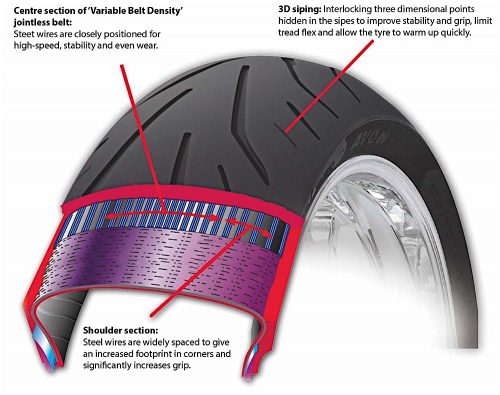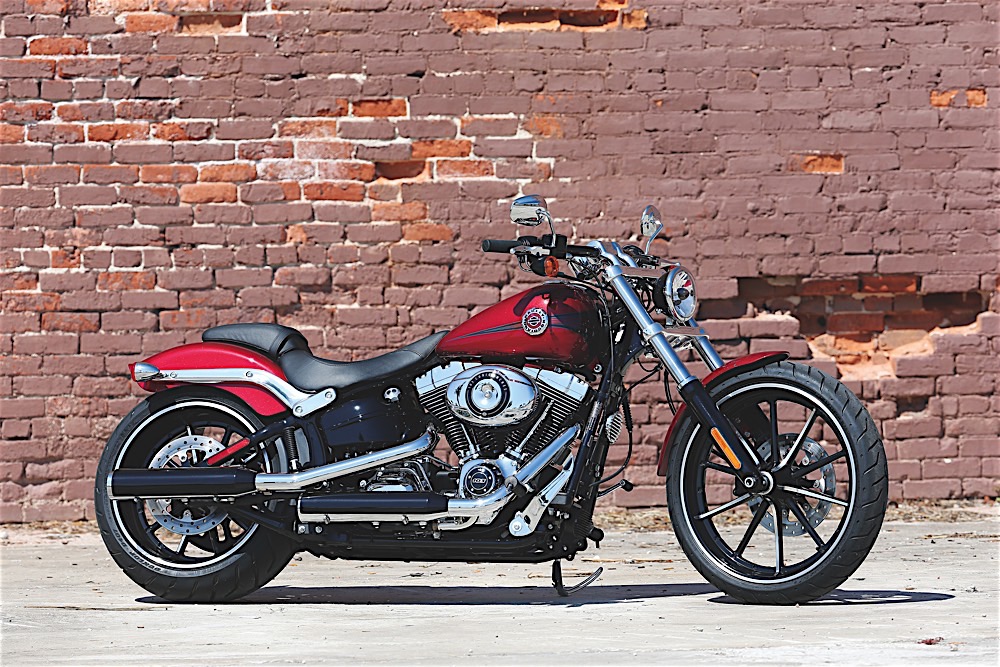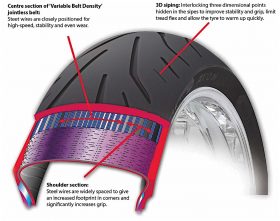In this second part of understanding tires, we’ll look at tire construction and how it affects your motorcycle.
There are two main types of tire carcass: bias-ply and radial. Tire manufacturers have developed several variations of each type, and have experimented with many belt patterns and materials. The difference between the two is the direction that the internal belts are moulded into the tire. In bias-ply tires, they run diagonally from bead to bead and crisscross with each ply. Radial tire belts run radially at about 90 degrees across the tire from bead to bead.
Bias ply tires have no distinctive markings to identify them as such, other than possibly a small “bias ply” embossed somewhere on the sidewall, or a hyphen or the tire’s load rating or speed index incorporated into the tire’s size. This will appear just before the tire diameter: 130/80-16 or 130/80H16. A radial tire will always have an “R” located before the tire diameter: 180/55R17.
Each of these very different types of tires is designed for a specific application. Also note that while bias-ply tires are available in tube-type and tubeless variations, radial tires are always of the tubeless types, though inner tubes can be used in them if required.
 Bias-ply tires have been around longer than radial tires, and they are more rigid. The criss-cross belt pattern provides more structural integrity, which makes the sidewalls as well as the overall tire stiffer. Because of their inherent stiffness, bias-ply tires can be mounted onto narrower rims. This is why most cruisers and off-road bikes are equipped with bias-ply tires, but it’s also because many of these types of motorcycles use spoke wheels, which are mostly designed to be mounted with inner tubes.
Bias-ply tires have been around longer than radial tires, and they are more rigid. The criss-cross belt pattern provides more structural integrity, which makes the sidewalls as well as the overall tire stiffer. Because of their inherent stiffness, bias-ply tires can be mounted onto narrower rims. This is why most cruisers and off-road bikes are equipped with bias-ply tires, but it’s also because many of these types of motorcycles use spoke wheels, which are mostly designed to be mounted with inner tubes.
Bias-ply tires also generally have higher weight ratings and can carry heavier loads. The drawback to bias-ply tires is that their stiff carcasses do little to damp road irregularities.
Radial tires were first invented for automobiles, and the main reason for their existence was to provide a smoother, quieter ride. All cars produced today use radial tires, but if you’re old enough to remember when cars were equipped with bias-ply tires, you’ll recall that they were easily distinguishable from radials because their sidewalls didn’t deform with the weight of the car. Radial tires, even when properly inflated, look a bit soft, bulging slightly where tire meets pavement.
Radial tires were adapted for motorcycles for the same reason: they provided a softer, more compliant ride. By winding the belts straight across the carcass, the tire acts more like a balloon, flexing when pressure is applied to its surface. This is why radial tires usually have short sidewalls; if they were too tall, the tire would become unstable. Radial tires also use fewer plies than bias-ply tires – in some cases, just one. When there is more than one ply, the first is wound radially around the tire; subsequent layers are wound diagonally for some structural rigidity, but they are at a shallower angle than in a bias-ply tire. On zero-degree radial tires, only a single-layer radial belt is used, so for added puncture resistance as well as some tread rigidity, steel or Kevlar belts run around the circumference of the tire (at zero or near-zero degrees). Kevlar replaces steel in high-performance tires to reduce weight.
This is also why ultra-high-performance motorcycles use low-profile tires; too much flexibility will have an adverse effect on high-speed handling. Because of this across-the-tire belt construction, a radial tire expands outwards at speed more than a bias-ply tire, though it is also designed to sustain higher speeds.
Aside from providing a softer ride, radial tires also offer an increased potential for grip. Because of its more pliable sidewalls, a radial tire’s contact patch will better contour around pavement irregularities, which in turn provides better traction. Even if two tires are of identical size and use an identical rubber compound, the radial will have better grip than the bias-ply tire.
It’s this sidewall pliability that also relegates radial tires to wider-rim applications; if a radial tire is mounted onto a narrower rim than it was designed for, the tire will lose some of its structural rigidity and have an increased tendency to deflect from side to side. This is why it is very important never to deviate from your bike’s original tire size. Most tire manufacturers publish recommended rim sizes for their own tires, which can be found on their respective websites.
When a motorcycle is created, the chassis is either designed to roll on bias-plies or radials, and you should stick to the same tire construction when replacing your tires. Some bikes, however, come with a mix of radial and bias-ply tires, and usually it is the wheel sizes that determine this combination. They are usually cruisers with a narrow, 21-inch front wheel and an ultra-wide rear wheel – for example, the Harley-Davidson Breakout, which uses a 130/60B21 on the front and a 240/40R18 on the rear.
Regardless of what type of tires your bike uses, make sure you check your tire pressures regularly; even a high-tech, steel-belted radial tire can fail if it is improperly inflated.
Technical articles are written purely as reference only and your motorcycle may require different procedures. You should be mechanically inclined to carry out your own maintenance and we recommend you contact your mechanic prior to performing any type of work on your bike.











